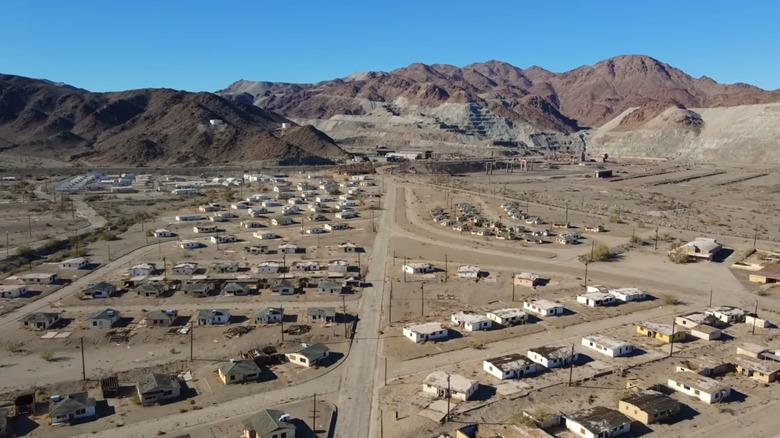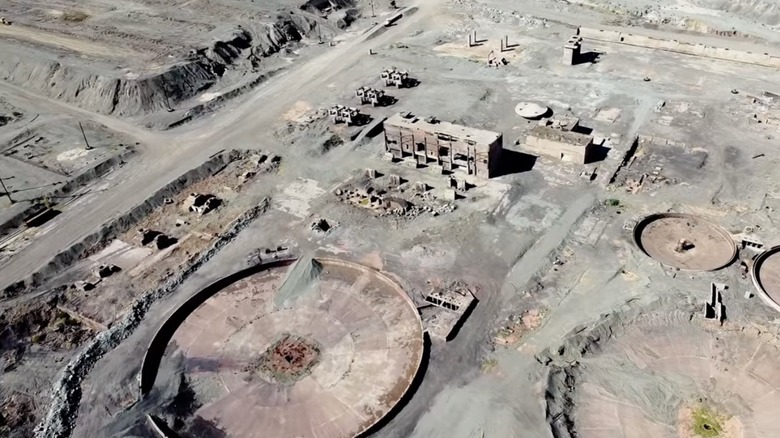One Of California's Largest Ghost Towns Is An Eerily Modern, Abandoned Mining Town
About three hours from Los Angeles, just outside the border of the scenic and giant rock-filled paradise of Joshua Tree National Park, sits an eerie, abandoned ghost town unlike any other in the state. Eagle Mountain, once home to California's largest iron mine, was a thriving company town from 1948 until its closure in 1983. With its nearly 4,000 residents forced to leave with the closing of the mine, Eagle Mountain turned into a ghost town almost overnight. Rusted buildings, abandoned machinery, cracked concrete, decrepit refineries, and a scarred mountain are all that remain of this place that was once a picture postcard of postwar America.
California has almost 300 ghost towns, most of which are linked to the state's mining history, like Bodie, famous for its well-preserved abandoned buildings and very cool temperatures. From the Gold Rush of the mid-1800s through World War II, mining towns popped up all around the Golden State, as industrialists, prospectors, and miners followed the pulsing veins of the earth, and towns were quickly abandoned once the mines ran out. These days, it's easy to see Eagle Mountain as an emblem of a dystopian future or the collapse of fragile economic and industrial bubbles, and perhaps you even have seen it as such since it's a favorite location for film and TV directors (eagle-eyed Christopher Nolan fans can spot it in the climax of 2020's "Tenet"). But the history of Eagle Mountain, one of California's largest and most modern ghost towns, goes much deeper than the rusting skeleton that remains today.
The postwar history of a modern mining town
The town of Eagle Mountain was built by the Kaiser Steel Corporation, owned by industrialist Henry J. Kaiser. Situated below an iron-rich hill next to Joshua Tree National Park, the town's mine opened in 1948. Over the next few decades, Eagle Mountain became one of the country's largest mining operations, even setting a record in 1975 when it produced 350,000 tons of material. With nearly 1,000 people working for the mine, Eagle Rock was a true company town: everyone and everything was in service of iron, and all was owned by the Kaiser Steel Corporation. Over 400 single-story, multi-bedroom houses lined the wide, tree-filled streets. A post office was built, along with a bowling alley, recreation hall, high school, baseball diamond, café, and a handful of churches.
While the town may have looked like a vision of traditional, post-war American comfort, it was also a hub for modernization. Eagle Mountain was one of the earliest places where Kaiser implemented the healthcare prepayment plan that led to the Health Maintenance Organization (HMO) model that his company, Kaiser Permanente, pioneered. Miners of Eagle Mountain took 5 cents out of their daily paycheck to put towards healthcare, which was not yet a commonplace practice at the time.
The life of Eagle Mountain started coming to an end in November 1981, when it was announced the mine would close and everyone would have to leave by the summer of 1983. For the last people there, the town became a shell of itself, with more buildings becoming abandoned seemingly from one moment to the next. Many residents were traumatized, but have stayed in touch online to keep the memories alive of this once close-knit community.
What happened to Eagle Mountain after it closed?
Since its closure, while Eagle Mountain has been mostly abandoned, it has continued to be used for different functions. The privately owned Eagle Mountain Community Correctional Facility operated from 1988 to 2003 out of several buildings, including the bowling alley and café. A violent race riot between inmates resulted in the death of two prisoners in 2003, although it was actually budgetary cuts that closed the prison that same year. While the high school saw its last graduating class in 1983, the Eagle Mountain Elementary School has remained in operation, bringing a handful of students to this building outside the fenced area of the town.
These days, Eagle Mountain has a few permanent residents to its name, courtesy of the foremen who live there to patrol it and guard the space against trespassers. In other words, you can't legally visit it and it's best not to try, since security is tight. That all might change someday, since SF Gate reported in 2023 that the site of the town and its mining claims were sold to a mystery buyer for a hefty price tag of $22.5 million. According to the outlet, the only public information about the buyer is that it's a company called Ecology Mountain Holdings LLC with a business address in Cerritos, California. Perhaps Eagle Mountain will be transformed into an outdoor museum like other abandoned mining towns, but at the time of this writing, current plans for this California desert ghost town remain unknown.


